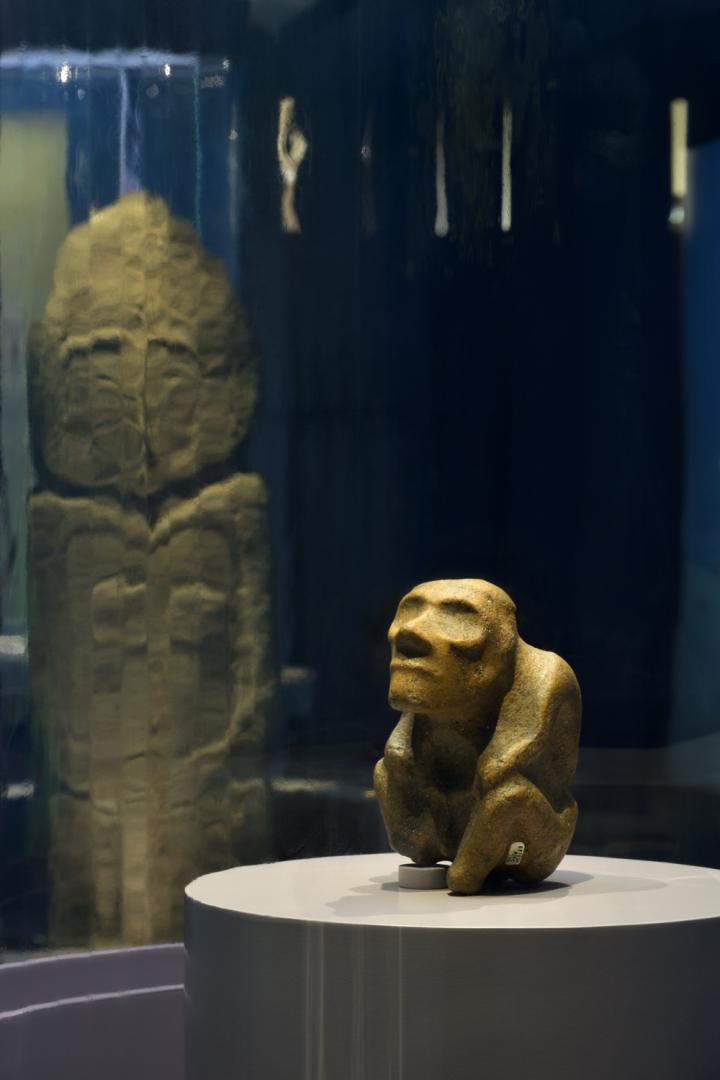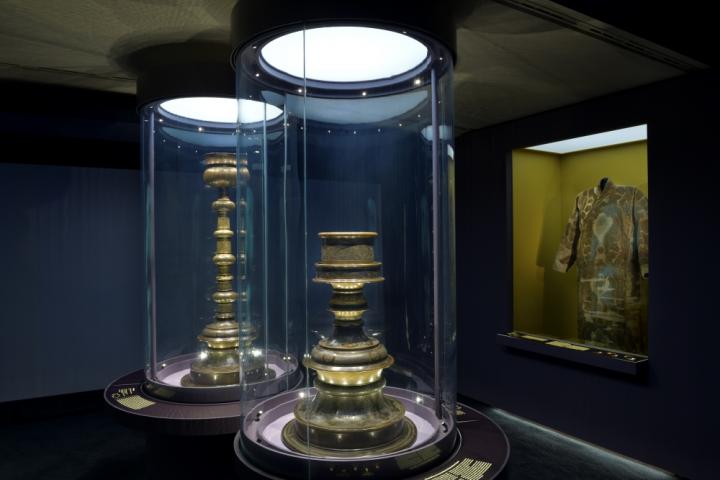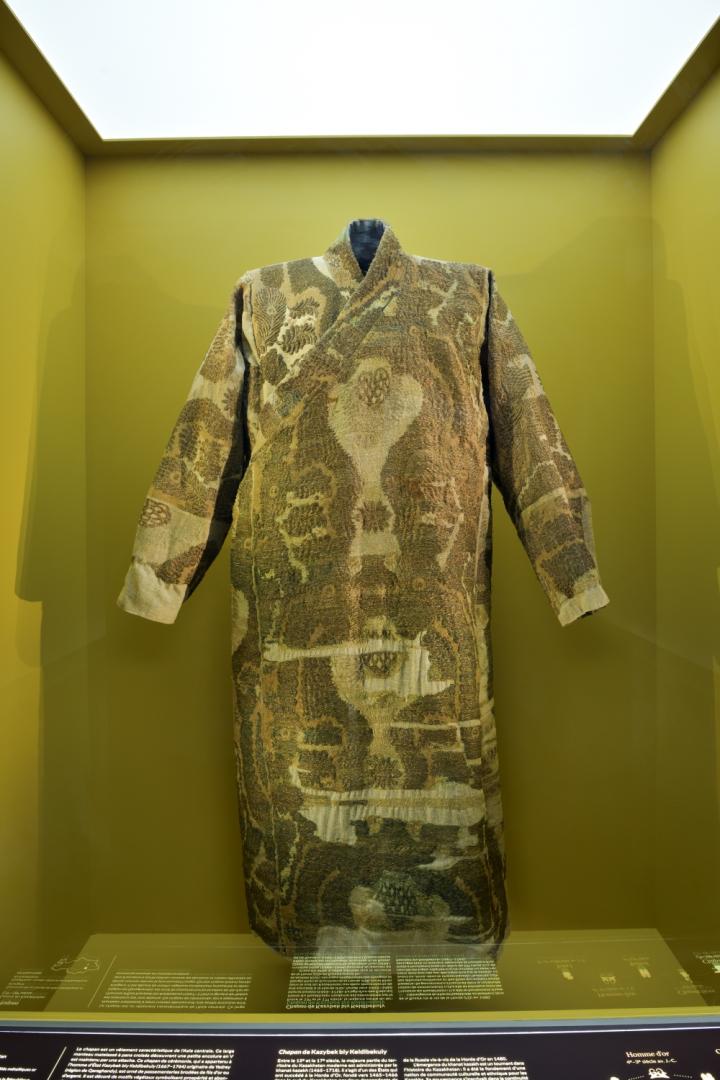Land of the Golden Man and the great kurgans, Kazakhstan is a country of legends on the edge of the steppes of Central Asia. Its vast landscape, across which a web of silk routes once stretched, is steeped in rich cultural and human history. With Kazakhstan, Treasures of the Great Steppe, Guimet sheds light on moments that have marked this civilisation through five unique cultural stories, dating from third century BCE to the 18th century. Thanks to exceptional loans from prominent Kazakh museums, these treasures — including the original headdress from the emblematic Golden Man — are presented in a poetic and innovative exhibition which plunges the objects and visitors into the extraordinary landscapes of Kazakhstan.
The sensorial and immersive world designed by scenographer Sylvain Roca transports visitors to the land where these masterpieces were created: successive projections and sound creations will animate the objects and poetically place them in their original context, offering them a suspended moment in time in another culture and land.
Kazakhstan: a country at the crossroads of European and Asian culture
Kazakhstan, one of the five countries that makes up Central Asia, lies at the crossroads of Asia and Europe and is a diverse land known for its unique history and culture.
Nomadic groups have been living on these lands since Antiquity, quickly domesticating this steppe region where they later built large urban dwellings. The abundance of natural resources, helped the development of international trade routes and economic ties, strengthening the region’s cultural identity. The Huns, the Scythians and the Turkic tribes played a key role in the formation of culture, identity and political alliances in Kazakhstan. After the decline of the Golden Horde, the Kazakh Khanate took over as the successor to the Genghis Khan empire, laying the foundations of traditional Kazakh civilisation.
Five moments in history with five masterpieces
Milestone 1: Tobol Thinker
Botai culture and the domestication of horses
The Botai culture marked by the domestication of horses emerged from North Kazakhstan around the fourth millennium BCE. This is considered as the foundation of the steppe civilisation and led to its strong development over the next millennium.
The transition from the traditional hunting lifestyle to a productive economy of horse and cattle breeding (maintaining hunting as a complement) was a major part of Kazakhstan’s legacy during this era. It reflects their deep understanding of the cycles of nature, the climate and the landscape, as well as the flora and the fauna that surrounded them. This understanding is embodied in objects such as the remarkable “Tobol Thinker”, also known as “Man watching the sky”, which was discovered in the Kostanay region. This small anthropomorphic figure reflects the spiritual culture and philosophical vision of the early steppe nomads.

© Lola Moser
Milestone 2: Golden Man
The emergence of the Scythian states
During the first millennium BCE, the large tribal groups and proto-states shared the same culture and started to develop in the Eurasian Steppe, eventually giving rise to the emergence of nomadic tribes that the Greeks and Persians would later refer to as the Scythians, the Saka or the Sarmatians.
The largest Saka States were established in Jetisu, in the southeast of Kazakhstan, in the northern steppe and lake region (Saryarka), close to the Aral Sea and in the Altai mountains. These diverse groups shared an ethic affinity and a similar level of development and lifestyle which generated common cultures, technologies and productions. One example is gold work, of which “animal motif” objects became particularly popular.
The discovery in 1969 of the “Golden man” in Issyk, Almaty region, caused a stir in the scientific community. The refinement of this man’s gold decorations and accessories attests to a mastery of goldsmithing techniques. The Golden Man also reflects the wealth of mythology and spirituality of the steppe civilisations. These nomads worshipped their leader, elevating him to the status of sun god. One of the silver bowls found near the same site bears traces of the oldest writing ever found from Central Asia.

© Lola Moser
Milestone 3: The balbals
Medieval Kazakhstan during domination by Turkic people
The Altai mountains was a region of great importance in the history of the Kazakhs and other Eurasian Turkic people. It is here, in the middle of the first millennium, that the Turkic culture established, writing a new chapter in the history of the steppes. In the mid-6th century, a new type of confederation of Turkic tribes was created: the khaganate (empire). This was a continuity model for the Turkic states in the centuries that followed, the Turgesh, Karlouk, Kimek and Kipchak khaganates which marked the history of medieval Kazakhstan.
The Turkic people managed to find a balance between nomadic life and life in a sedentary, urbanised world, where trade, arts and science flourished. One of these cities, Otrar (also called Fareb), was the birthplace of the early Islamic philosopher Abu Nasr al-Farabi, known as the “second master” after Aristotle.
The balbals are megalithic stone stelae and one of the most emblematic monuments of the Turkic nomads. These anthropomorphic sculptures have stylized features to identify male or female figures and were prevalent throughout the steppe region.

© Lola Moser
Milestone 4: Chandeliers from the Mausoleum Khoja Ahmet Yasawi
The development of Islam
Ahmet Yasawi was a poet and distinguished Sufi master from the 12th century who played a decisive role in the development of Islam and Sufism in the Turkic-speaking areas of Central Asia. He spent most of his life in the town of Yasi, now known as Turkistan, a prosperous oasis on the trade routes linking China to the Middle East. His mausoleum was built during the rule of Timur (also known as Tamerlane), from 1389 to 1405. For this monument, Persian builders experimented new architectural solutions, notably blue and turquoise tiles decorated with geometric motifs, which were later used for the construction of Samarkand, the capital of the Timurid Empire.
Today, it is one of the largest and best-preserved constructions by the Timurids whose vast empire included Iran and Central Asia.
Timur had commissioned six chandeliers for the interior. Made from metal, and probably inlaid with gold and silver, these chandeliers are a fine example of Islamic decorative art from the Timurid period. They were considered fine luxury items and were inscribed with either the commissioner’s or the artisan’s name and the production date.

© Lola Moser
Milestone 5: Chapan of Kazybek biy Keldibekuly
The Kazakh Khanate and the emergence of modern Kazakhstan
Between the 15th and 17th centuries, the majority of modern Kazakhstan was
ruled by the Kazakh Khanate (1465-1718). This was a state which succeeded the Golden Horde and was established around 1465-1466 in south Kazakhstan by two descendants of Genghis Khan and the Golden Horde, Kerei Khan and Janibek Khan, while the hegemony of the Mongols and the Golden Horde was reaching an end in Eurasia.
It was during this period that the Ming (1368-1644) came to power in China after the fall of the Yuan dynasty (1234-1368) founded by the Mongols, and when Ivan III of Russia, also known as Ivan the Great, (r. 1462-1505), declared the independence of Russia from the Golden Horde in 1480.
The emergence of the Kazakh Khanate marked a turning point in the history of Kazakhstan: it was established as an ethnic and cultural community for the Kazakhs. Its governance continued to respect existing political unions and states, and judicial authority was exercised by judges elected by the people. Their court, which was adapted to nomadic or semi-nomadic life, continued to be used until the early 19th century. One of these judges was a distinguished diplomat and statesman, Kazybek biy Keldibekuly (1667-1764).

© Lola Moser
Scientific Director of the exhibition: Yannick Lintz, President of Guimet French National Museum of Asian Arts and Valérie Zaleski, curator of the Chinese and Central Asian Buddhist art collections, Guimet Museum.
This exhibition is organised by Guimet Museum and the National Museum of the Republic of Kazakhstan
Elle a bénéficié du soutien de la fondation Bulat Utemuratov et d’Alstom Kazakhstan
Partenaires média





